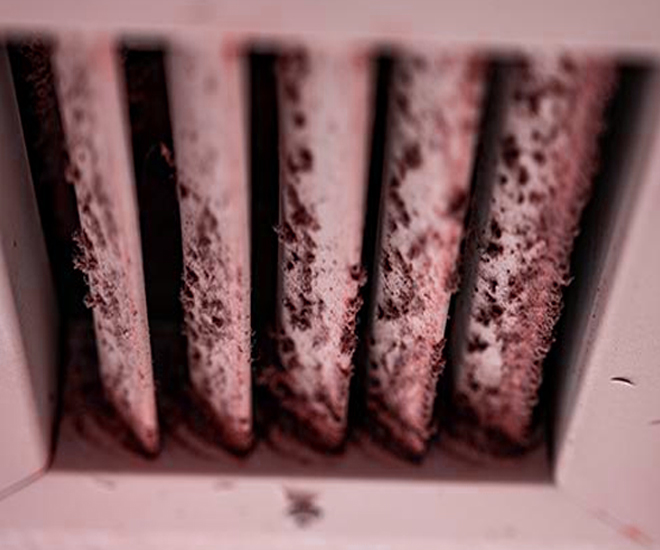
Understanding how to get rid of mold in air conditioning ducts is crucial for maintaining a healthy living environment. Furthermore, the presence of mold in air conditioning ducts can greatly affect both the efficiency of your HVAC system and the quality of your indoor air. Therefore, we should always take this issue seriously. In this guide, we’ll explore effective methods for mold removal from AC ducts, prevention strategies, and when to seek professional help.
Why Does Mold Grow in Air Conditioners Ducts
Mold loves damp and dark environments and as your air conditioner ducts can fulfill all these needs, therefore, they become mold’s prime target. Moreover, moisture from condensation, leaks, or high humidity provides the perfect breeding ground for mold spores. In addition, when dust and debris make their way into AC ducts they further exacerbate the problem by offering mold a proper food source.
Signs and Symptoms of Mold in Air Ducts
Identifying mold early can prevent health issues and extensive damage. Look for these signs:
- Visible Mold: Thoroughly check the air vents and look for discolored patches.
- Musty Odors: A persistent moldy smell, especially when the HVAC system is running.
- Allergy Symptoms: If you are observing a sudden increase in coughing, sneezing, and respiratory issues when indoors then it is another vital sign.
- Inefficient HVAC System: Reduced airflow and uneven cooling or heating.
How to Get Mold Out of Air Ducts
Removing mold from air ducts requires a strategic approach. Here are some effective DIY methods of how to clean mold from air ducts:
Use Baking Soda
- Mix: Combine baking soda with water to form a paste.
- Apply: After that, spread the mixture on the affected area, let it sit, then scrub and wipe clean.
- Benefits: Not only, it will absorb all the moisture but will also neutralize odors.
Use Vinegar
- Spray: Take equal quantities of water and white vinegar and mix. Now spray on mold.
- Wait: Allow it to sit for a while, then scrub and wipe away.
- Benefits: White vinegar contains natural antimicrobial properties which instantly kills mold spores.
Use Tea Tree Oil
- Prepare: Mix a few drops of tea tree oil with water.
- Apply: Spray on mold, let it sit, then scrub and wipe clean.
- Benefits: Strong antifungal and antibacterial properties.
Use Hydrogen Peroxide
- Mix: Combine equal parts of 3% hydrogen peroxide and water.
- Apply: Now spray this mixture on the areas affected by mold. After that, wait for 10 minutes, then scrub and wipe clean.
- Benefits: Hydrogen peroxide kills mold spores very effectively.
Use Borax
- Prepare: Mix borax with water.
- Apply: Scrub the moldy areas with the solution, then wipe clean.
- Benefits: Prevents future mold growth.
Use a HEPA Vacuum
- Vacuum: Use a HEPA vacuum to capture mold spores from accessible areas.
- Benefits: Reduces mold spores in the air but may not eliminate the source.
Use a Mold Removal Fogger
- Fogging: Use a fogger to disperse mold-killing solution throughout the ductwork.
- Benefits: Reaches hard-to-access areas.
Professional Mold Removal
For extensive mold problems, hiring a professional is advisable. Professionals can:
- Conduct Thorough Inspections: Unlike, a layman the experts come with the appropriate knowledge to handle such tasks. They start with identifying the source of moisture and mold.
- Use Advanced Techniques: Professionals use the most suitable equipment for the job and employ specialized methods.
- Ensure Complete Removal: Address both visible and hidden mold.
How to Prevent Mold in HVAC Systems
Preventing mold growth is key to maintaining a healthy HVAC system. Here are some tips:
Control Moisture
- Fix Leaks: Always promptly fix any plumbing or roof leaks promptly.
- Use Dehumidifiers: Utilize dehumidifiers as only then you can maintain low indoor humidity levels.
- Ensure Proper Ventilation: Use exhaust fans in damp and mold-prone areas like kitchens and bathrooms.
Routine HVAC Maintenance
- Regular Inspections: The best practice is to have your HVAC system inspected and maintained regularly.
- Replace Filters: Filters become dirty very easily so you should change filters every three months.
- Clean Coils: Ensure the coils are clean to prevent moisture buildup.
Use Quality Air Filters
- Install HEPA Filters: Capture mold spores and other particles, preventing them from circulating.
Install UV Lights
- UV Lights: These lights are the quickest and most efficient way to kill mold in HVAC systems. Therefore, never neglect to Install UV lights in the HVAC system to kill mold spores and other microorganisms.
Protect Ductwork
- Seal and Insulate: Properly seal and insulate ductwork to prevent condensation.
Does Air Duct Cleaning Get Rid of Mold?
No doubt, professionals can effectively kill and remove mold from air ducts. However, you won’t be able to hold it off for so long if you are unaware of how to prevent mold in HVAC system. Therefore, it is essential to address the underlying moisture issues to prevent mold from returning. Furthermore, regular cleaning and maintenance, combined with the preventive measures mentioned, can help keep your air ducts mold-free.
Conclusion
In conclusion, knowing how to get rid of mold in air conditioning ducts is crucial for maintaining a healthy home and efficient HVAC system. Furthermore, while DIY methods like using baking soda, vinegar, and tea tree oil can be effective for minor mold issues, persistent or extensive mold problems require professional intervention. Therefore, for residents in Miami, Miami Mold Specialists offers expert services that ensure thorough mold inspection, advanced mold removal techniques, and long-term prevention strategies. By addressing both visible and hidden mold and fixing underlying moisture problems, Miami Mold Specialist helps maintain a mold-free environment in your HVAC system, safeguarding your health and enhancing indoor air quality.







